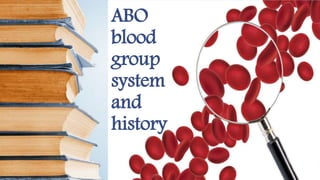ABO blood group system and history
•Download as PPTX, PDF•
10 likes•3,925 views
a brief description of ABO blood group description
Report
Share
Report
Share

Recommended
Recommended
More Related Content
What's hot
What's hot (20)
Similar to ABO blood group system and history
Similar to ABO blood group system and history (20)
Abo blood group system by Pandian M, Tutor, Dept of Physiology, DYPMCKOP.

Abo blood group system by Pandian M, Tutor, Dept of Physiology, DYPMCKOP.
Different blood groups and their their significances..

Different blood groups and their their significances..
1 BIOL 102 Lab 9 Simulated ABO and Rh Blood Typing.docx

1 BIOL 102 Lab 9 Simulated ABO and Rh Blood Typing.docx
More from Syeda Maryam
More from Syeda Maryam (15)
Bordetella (Gram-Negative Rod Related to the Respiratory Tract)

Bordetella (Gram-Negative Rod Related to the Respiratory Tract)
CAMPYLOBACTER & HELICOBACTER (Curved Gram-Negative Rods affecting the GIT)

CAMPYLOBACTER & HELICOBACTER (Curved Gram-Negative Rods affecting the GIT)
DIFFERENCE BETWEEN BENIGN AND MALIGNANT NEOPLASM (CANCER)

DIFFERENCE BETWEEN BENIGN AND MALIGNANT NEOPLASM (CANCER)
MECHANISM of ACTION of some GRAM positive BACTERIA’s exotoxin

MECHANISM of ACTION of some GRAM positive BACTERIA’s exotoxin
Recently uploaded
Recently uploaded (20)
❤Jammu Kashmir Call Girls 8617697112 Personal Whatsapp Number 💦✅.

❤Jammu Kashmir Call Girls 8617697112 Personal Whatsapp Number 💦✅.
Pulmonary drug delivery system M.pharm -2nd sem P'ceutics

Pulmonary drug delivery system M.pharm -2nd sem P'ceutics
300003-World Science Day For Peace And Development.pptx

300003-World Science Day For Peace And Development.pptx
Biogenic Sulfur Gases as Biosignatures on Temperate Sub-Neptune Waterworlds

Biogenic Sulfur Gases as Biosignatures on Temperate Sub-Neptune Waterworlds
Pests of mustard_Identification_Management_Dr.UPR.pdf

Pests of mustard_Identification_Management_Dr.UPR.pdf
SAMASTIPUR CALL GIRL 7857803690 LOW PRICE ESCORT SERVICE

SAMASTIPUR CALL GIRL 7857803690 LOW PRICE ESCORT SERVICE
development of diagnostic enzyme assay to detect leuser virus

development of diagnostic enzyme assay to detect leuser virus
Locating and isolating a gene, FISH, GISH, Chromosome walking and jumping, te...

Locating and isolating a gene, FISH, GISH, Chromosome walking and jumping, te...
Asymmetry in the atmosphere of the ultra-hot Jupiter WASP-76 b

Asymmetry in the atmosphere of the ultra-hot Jupiter WASP-76 b
ABO blood group system and history
- 2. BLOOD GROUP • Definition • BLOOD GROUP is one of the classes (such as those designated A, B, AB, or O) into which individuals or their blood can be separated on the basis of the presence or absence of specific antigens in the blood. — also called BLOOD TYPE.
- 3. TYPES of BLOOD GROUP SYSTEM
- 4. ABO blood group system • It is a major human blood group system. The ABO type of a person depends on the presence or absence of three genes, A and B and O. These genes determine the configuration of the red blood cell surface.
- 5. HISTORYThe ABO blood types were first discovered by an Austrian Physician Karl Landsteiner working at the Pathological-Anatomical Institute of the University of Vienna in1900. In 1900, he found that blood sera from different persons would clump together (agglutinate) when mixed in test tubes, and not only that some human blood also agglutinated with animal blood. This was the first evidence that blood variation exists in humans ,but before it was believed that all humans have similar blood. In 1901, he made a definitive observation that blood serum of an individual would not agglutinate with only those of certain individuals. Based on this he classified human bloods into three groups, namely group A, group B, and group C. He defined that group A blood agglutinates with group B, but never with its own type. Similarly, group B blood agglutinates with group A. Group C blood is different in that it agglutinates with both A and B. His third group (C) indicated absence of both A and B antigens, but contains anti-A and anti-B, thus designated as O (null) group The following year, his students Adriano Sturli and Alfred von Decastello discovered the fourth type ,designated as AB group containing both A and B antigen but no antibody
- 7. BLOOD ANTIGEN An antigen is a substance foreign to the body that causes an immune response. The ABO antigen is a glycosyl-transferase that is encoded, for which three are major alleles, A, B and O. The A and B alleles catalyze addition of different carbohydrate residues (N-acetyl glactosamine for group A and d-glactose for group B) to a basic antigenic glycoprotein or glycolipid with terminal sugar1-fucose on the red cell, known as the H SUBSTANCE. The O allele is non-functional that’s why doesn’t modify the H substance. The A allele actually itself has 2 variant, A1 and A2 , which further complicates the issue but they are of minor clinical significance . A2 cell react more weakly than A1 cells with anti-A, patients who are A2B can be wrongly grouped as B. The A,B and H antigens are present on most body cells including white cells and platelets . In 80% of population who posses secretor genes, these antigens are also found in soluble form in secretions and body fluids ( e.g. plasma, saliva, semen, and sweat).
- 8. BLOOD GROUP ANTIBODIES Antibodies, also known as immunoglobulins, are Y-shaped proteins that are produced by the immune system to help stop intruders from harming the body. The most of the natural antibodies are anti-A and anti-B .The natural antibodies are usually immunoglobulin M (IgM) and react optimally at cold temperature(4 C) so, although reactive at 37C are called COLD ANTIBODIES The immune antibodies develop in response of transfusion and transplacental passage during pregnancy .these are commonly IgG, although some IgM may also develop , usually in early phase of immune response. These antibodies react optimally at 37C called warm antibodies. Only IgG antibodies are capable of transplacental passage from mother to fetus and the most important immune antibody is the Rh antibody, anti-D.